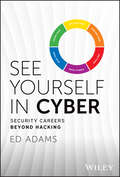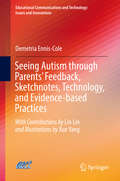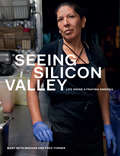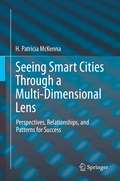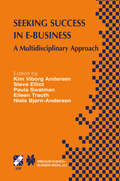- Table View
- List View
Security with Noisy Data: On Private Biometrics, Secure Key Storage and Anti-Counterfeiting
by Pim Tuyls Boris Skoric Tom KevenaarNoisy data appear very naturally in applications where the authentication is based on physical identifiers. This book provides a self-contained overview of the techniques and applications of security based on noisy data. It provides a comprehensive overview of the theory of extracting cryptographic keys from noisy data, and describes applications in the field of biometrics, secure key storage, and anti-counterfeiting.
Security without Obscurity: A Guide to Cryptographic Architectures
by Jeff StapletonInformation security has a major gap when cryptography is implemented. Cryptographic algorithms are well defined, key management schemes are well known, but the actual deployment is typically overlooked, ignored, or unknown. Cryptography is everywhere. Application and network architectures are typically well-documented but the cryptographic architecture is missing. This book provides a guide to discovering, documenting, and validating cryptographic architectures. Each chapter builds on the next to present information in a sequential process. This approach not only presents the material in a structured manner, it also serves as an ongoing reference guide for future use.
Security without Obscurity: A Guide to Cryptographic Architectures
by Jeff StapletonInformation security has a major gap when cryptography is implemented. Cryptographic algorithms are well defined, key management schemes are well known, but the actual deployment is typically overlooked, ignored, or unknown. Cryptography is everywhere. Application and network architectures are typically well-documented but the cryptographic architecture is missing. This book provides a guide to discovering, documenting, and validating cryptographic architectures. Each chapter builds on the next to present information in a sequential process. This approach not only presents the material in a structured manner, it also serves as an ongoing reference guide for future use.
Security without Obscurity: Frequently Asked Questions (FAQ)
by Jeff StapletonSecurity without Obscurity: Frequently Asked Questions (FAQ) complements Jeff Stapleton’s three other Security without Obscurity books to provide clear information and answers to the most commonly asked questions about information security (IS) solutions that use or rely on cryptography and key management methods. There are good and bad cryptography, bad ways of using good cryptography, and both good and bad key management methods. Consequently, information security solutions often have common but somewhat unique issues. These common and unique issues are expressed as an FAQ organized by related topic areas. The FAQ in this book can be used as a reference guide to help address such issues. Cybersecurity is based on information technology (IT) that is managed using IS controls, but there is information, misinformation, and disinformation. Information reflects things that are accurate about security standards, models, protocols, algorithms, and products. Misinformation includes misnomers, misunderstandings, and lack of knowledge. Disinformation can occur when marketing claims either misuse or abuse terminology, alluding to things that are inaccurate or subjective. This FAQ provides information and distills misinformation and disinformation about cybersecurity. This book will be useful to security professionals, technology professionals, assessors, auditors, managers, and hopefully even senior management who want a quick, straightforward answer to their questions. It will serve as a quick reference to always have ready on an office shelf. As any good security professional knows, no one can know everything.
Security without Obscurity: Frequently Asked Questions (FAQ)
by Jeff StapletonSecurity without Obscurity: Frequently Asked Questions (FAQ) complements Jeff Stapleton’s three other Security without Obscurity books to provide clear information and answers to the most commonly asked questions about information security (IS) solutions that use or rely on cryptography and key management methods. There are good and bad cryptography, bad ways of using good cryptography, and both good and bad key management methods. Consequently, information security solutions often have common but somewhat unique issues. These common and unique issues are expressed as an FAQ organized by related topic areas. The FAQ in this book can be used as a reference guide to help address such issues. Cybersecurity is based on information technology (IT) that is managed using IS controls, but there is information, misinformation, and disinformation. Information reflects things that are accurate about security standards, models, protocols, algorithms, and products. Misinformation includes misnomers, misunderstandings, and lack of knowledge. Disinformation can occur when marketing claims either misuse or abuse terminology, alluding to things that are inaccurate or subjective. This FAQ provides information and distills misinformation and disinformation about cybersecurity. This book will be useful to security professionals, technology professionals, assessors, auditors, managers, and hopefully even senior management who want a quick, straightforward answer to their questions. It will serve as a quick reference to always have ready on an office shelf. As any good security professional knows, no one can know everything.
Security without Obscurity: A Guide to PKI Operations
by Jeff Stapleton W. Clay EpsteinMost books on public key infrastructure (PKI) seem to focus on asymmetric cryptography, X.509 certificates, certificate authority (CA) hierarchies, or certificate policy (CP), and certificate practice statements. While algorithms, certificates, and theoretical policy are all excellent discussions, the real-world issues for operating a commercial or
Security without Obscurity: A Guide to PKI Operations
by Jeff Stapleton W. Clay EpsteinMost books on public key infrastructure (PKI) seem to focus on asymmetric cryptography, X.509 certificates, certificate authority (CA) hierarchies, or certificate policy (CP), and certificate practice statements. While algorithms, certificates, and theoretical policy are all excellent discussions, the real-world issues for operating a commercial or
Security Without Obscurity: A Guide to PKI Operations
by Jeff Stapleton W. Clay EpsteinPublic Key Infrastructure (PKI) is an operational ecosystem that employs key management, cryptography, information technology (IT), information security (cybersecurity), policy and practices, legal matters (law, regulatory, contractual, privacy), and business rules (processes and procedures). A properly managed PKI requires all of these disparate disciplines to function together – coherently, efficiently, effectually, and successfully. Clearly defined roles and responsibilities, separation of duties, documentation, and communications are critical aspects for a successful operation. PKI is not just about certificates, rather it can be the technical foundation for the elusive "crypto-agility," which is the ability to manage cryptographic transitions. The second quantum revolution has begun, quantum computers are coming, and post-quantum cryptography (PQC) transitions will become PKI operation’s business as usual.
Security Without Obscurity: A Guide to PKI Operations
by Jeff Stapleton W. Clay EpsteinPublic Key Infrastructure (PKI) is an operational ecosystem that employs key management, cryptography, information technology (IT), information security (cybersecurity), policy and practices, legal matters (law, regulatory, contractual, privacy), and business rules (processes and procedures). A properly managed PKI requires all of these disparate disciplines to function together – coherently, efficiently, effectually, and successfully. Clearly defined roles and responsibilities, separation of duties, documentation, and communications are critical aspects for a successful operation. PKI is not just about certificates, rather it can be the technical foundation for the elusive "crypto-agility," which is the ability to manage cryptographic transitions. The second quantum revolution has begun, quantum computers are coming, and post-quantum cryptography (PQC) transitions will become PKI operation’s business as usual.
Security without Obscurity: A Guide to Confidentiality, Authentication, and Integrity
by J.J. StapletonThe traditional view of information security includes the three cornerstones: confidentiality, integrity, and availability; however the author asserts authentication is the third keystone. As the field continues to grow in complexity, novices and professionals need a reliable reference that clearly outlines the essentials. Security without Obscurit
Security@Work: Pragmatische Konzeption und Implementierung von IT-Sicherheit mit Lösungsbeispielen auf Open-Source-Basis (X.systems.press)
by Jörg Eschweiler Daniel E. Atencio PsilleDie Autoren erläutern die konzeptionellen und technischen Grundlagen des Themas IT-Sicherheit anhand anschaulicher Beispiele. Im Fokus stehen dabei die praktische Verwendbarkeit realitätsnaher Konzepte und Techniken. Hierzu werden ebenfalls aktuelle Standards erläutert und eingebunden. Um die Komplexität des Themas und seine Abhängigkeiten darzustellen, werden die Integration der einzelnen Bausteine sowie der Betrieb eines solchen Verbundes von IT-Komponenten sowohl aus technischer als auch administrativer Sicht und unter dem Aspekt der Integration in eine organisationsweite IT-Infrastruktur betrachtet. Das Buch bietet technisch versierten Einsteigern und Administratoren eine umfassende Grundlage für die weitergehende Auseinandersetzung mit dem Thema IT-Sicherheit.
The Seductive Computer: Why IT Systems Always Fail
by Derek PartridgeIT systems explode budget estimates, bust production deadlines by years, and then fail to work properly. Why this IT-system crisis? Poor programmers? Inadequate project management? No. The Seductive Computer argues that the fundamental nature of programming technology itself is the real culprit; it promises perfection but can only deliver emergent chaos. It is also an insidiously compelling technology, peculiarly male oriented. IT systems, an unavoidable and increasing reality in all our lives, are something new to man - large-scale discrete complexity. The Seductive Computer explains this novelty that defies human understanding. This book illustrates in a simple yet thorough manner the underlying concepts necessary for understanding the IT-system crisis - not ‘How To Program’ but what the demands of programming are. It then proceeds to lay out the full gamut of issues - all stemming from the nature of the technology. From development to maintenance IT-system personnel are grappling with incipient chaos. The technicians are seduced by the detailed challenge of the technology. The scientists are seduced by the promises of their technology. The managers and users are seduced by the mysteries of the technology. No IT system is ever fully understood by anyone, so surprising behaviours will always emerge. What can be done? We must rein in our expectations of IT systems: what they can do, and how reliably they can do it. On the positive side, The Seductive Computer discusses novel paradigms that look beyond the current discrete technology: neural computing and precise approximation computing.
See MIPS Run (ISSN)
by Dominic SweetmanSee MIPS Run, Second Edition, is not only a thorough update of the first edition, it is also a marriage of the best-known RISC architecture--MIPS--with the best-known open-source OS--Linux. The first part of the book begins with MIPS design principles and then describes the MIPS instruction set and programmers’ resources. It uses the MIPS32 standard as a baseline (the 1st edition used the R3000) from which to compare all other versions of the architecture and assumes that MIPS64 is the main option. The second part is a significant change from the first edition. It provides concrete examples of operating system low level code, by using Linux as the example operating system. It describes how Linux is built on the foundations the MIPS hardware provides and summarizes the Linux application environment, describing the libraries, kernel device-drivers and CPU-specific code. It then digs deep into application code and library support, protection and memory management, interrupts in the Linux kernel and multiprocessor Linux. Sweetman has revised his best-selling MIPS bible for MIPS programmers, embedded systems designers, developers and programmers, who need an in-depth understanding of the MIPS architecture and specific guidance for writing software for MIPS-based systems, which are increasingly Linux-based.Completely new material offers the best explanation available on how Linux runs on real hardwareProvides a complete, updated and easy-to-use guide to the MIPS instruction set using the MIPS32 standard as the baseline architecture with the MIPS64 as the main optionRetains the same engaging writing style that made the first edition so readable, reflecting the authors 20+ years experience in designing systems based on the MIPS architecture
See Yourself in Cyber: Security Careers Beyond Hacking
by Ed AdamsA one-of-a-kind discussion of how to integrate cybersecurity into every facet of your organization In See Yourself in Cyber: Security Careers Beyond Hacking, information security strategist and educator Ed Adams delivers a unique and insightful discussion of the many different ways the people in your organization—inhabiting a variety of roles not traditionally associated with cybersecurity—can contribute to improving its cybersecurity backbone. You’ll discover how developers, DevOps professionals, managers, and others can strengthen your cybersecurity. You’ll also find out how improving your firm’s diversity and inclusion can have dramatically positive effects on your team’s talent. Using the familiar analogy of the color wheel, the author explains the modern roles and responsibilities of practitioners who operate within each “slice.” He also includes: Real-world examples and case studies that demonstrate the application of the ideas discussed in the book Many interviews with established industry leaders in a variety of disciplines explaining what non-security professionals can do to improve cybersecurity Actionable strategies and specific methodologies for professionals working in several different fields interested in meeting their cybersecurity obligationsPerfect for managers, directors, executives, and other business leaders, See Yourself in Cyber: Security Careers Beyond Hacking is also an ideal resource for policymakers, regulators, and compliance professionals.
See Yourself in Cyber: Security Careers Beyond Hacking
by Ed AdamsA one-of-a-kind discussion of how to integrate cybersecurity into every facet of your organization In See Yourself in Cyber: Security Careers Beyond Hacking, information security strategist and educator Ed Adams delivers a unique and insightful discussion of the many different ways the people in your organization—inhabiting a variety of roles not traditionally associated with cybersecurity—can contribute to improving its cybersecurity backbone. You’ll discover how developers, DevOps professionals, managers, and others can strengthen your cybersecurity. You’ll also find out how improving your firm’s diversity and inclusion can have dramatically positive effects on your team’s talent. Using the familiar analogy of the color wheel, the author explains the modern roles and responsibilities of practitioners who operate within each “slice.” He also includes: Real-world examples and case studies that demonstrate the application of the ideas discussed in the book Many interviews with established industry leaders in a variety of disciplines explaining what non-security professionals can do to improve cybersecurity Actionable strategies and specific methodologies for professionals working in several different fields interested in meeting their cybersecurity obligationsPerfect for managers, directors, executives, and other business leaders, See Yourself in Cyber: Security Careers Beyond Hacking is also an ideal resource for policymakers, regulators, and compliance professionals.
Seeing Autism through Parents’ Feedback, Sketchnotes, Technology, and Evidence-based Practices (Educational Communications and Technology: Issues and Innovations)
by Demetria Ennis-ColeSeeing Autism is a comprehensive but easy-to-understand guidebook for caretakers, parents, educators, counselors, therapists, and researchers on various aspects of rearing and supporting children with autism spectrum disorder. It provides textual and visual information on technology tools, symptoms, diagnosis, auditory, sensory, visual, physical, and educational issues, as well as strategies and practices to help children on the Autism Spectrum reach their potential. Seeing Autism uniquely capitalizes on sketchnotes, a visual thinking tool, to communicate information and practices. Sketchnotes provide a unique space that can help the reader think differently, generate a variety of ideas, explore alternatives, and develop constructive points for expressing ideas and developing visual communication aids. This book will assist parents, educators, and professionals in schools (counselors, school psychologists, librarians) who work with children diagnosed with ASD; it will help readers increase their knowledge of autism and gain an appreciation for evidence-based practices and forms of technology that can be used to support learners on the autism spectrum. “This book is a call to arms and is as much a resource for the family friend as it is for the provider coming to the home. In the book Seeing Autism, Dr. Demetria Ennis-Cole helps individuals gain an incredible perspective and learn the struggles, challenges and joys of families rearing children, teens and adults on the spectrum. This book covers the entire spectrum and is a fantastic mix of research, parent perspective, and even sketchnotes for visual learners. The material is well-balanced and is a great resource to support individuals on the spectrum at home, in the community or in the classroom." Brad McGarryFather, Speaker, Author and Director of the Autism Initiative at Mercyhurst University
Seeing Between the Pixels: Pictures in Interactive Systems
by Christine Strothotte Thomas StrothotteThis practical and informative book highlights the relationship between pictures and linguistic representations of information. The authors define a new classification for pictures that focuses on the tasks users carry out with the help of images on computer screens, and present a model for analyzing and influencing the flow of information. For specialists in computer science, the book bridges the gap between computer graphics and human-computer interaction, while for general readers, it offers a wealth of insights and practical advice on how to use pictures as a medium of communication.
Seeing Cities Through Big Data: Research, Methods and Applications in Urban Informatics (Springer Geography)
by Piyushimita Vonu Thakuriah Nebiyou Tilahun Moira ZellnerThis book introduces the latest thinking on the use of Big Data in the context of urban systems, including research and insights on human behavior, urban dynamics, resource use, sustainability and spatial disparities, where it promises improved planning, management and governance in the urban sectors (e.g., transportation, energy, smart cities, crime, housing, urban and regional economies, public health, public engagement, urban governance and political systems), as well as Big Data’s utility in decision-making, and development of indicators to monitor economic and social activity, and for urban sustainability, transparency, livability, social inclusion, place-making, accessibility and resilience.
Seeing Silicon Valley: Life inside a Fraying America
by Mary Beth Meehan Fred TurnerAcclaimed photographer Mary Beth Meehan and Silicon Valley culture expert Fred Turner join forces to give us an unseen view of the heart of the tech world. It’s hard to imagine a place more central to American mythology today than Silicon Valley. To outsiders, the region glitters with the promise of extraordinary wealth and innovation. But behind this image lies another Silicon Valley, one segregated by race, class, and nationality in complex and contradictory ways. Its beautiful landscape lies atop underground streams of pollutants left behind by decades of technological innovation, and while its billionaires live in compounds, surrounded by redwood trees and security fences, its service workers live in their cars. With arresting photography and intimate stories, Seeing Silicon Valley makes this hidden world visible. Instead of young entrepreneurs striving for efficiency in minimalist corporate campuses, we see portraits of struggle—families displaced by an impossible real estate market, workers striving for a living wage, and communities harmed by environmental degradation. If the fate of Silicon Valley is the fate of America—as so many of its boosters claim—then this book gives us an unvarnished look into the future.
Seeing Silicon Valley: Life inside a Fraying America
by Mary Beth Meehan Fred TurnerAcclaimed photographer Mary Beth Meehan and Silicon Valley culture expert Fred Turner join forces to give us an unseen view of the heart of the tech world. It’s hard to imagine a place more central to American mythology today than Silicon Valley. To outsiders, the region glitters with the promise of extraordinary wealth and innovation. But behind this image lies another Silicon Valley, one segregated by race, class, and nationality in complex and contradictory ways. Its beautiful landscape lies atop underground streams of pollutants left behind by decades of technological innovation, and while its billionaires live in compounds, surrounded by redwood trees and security fences, its service workers live in their cars. With arresting photography and intimate stories, Seeing Silicon Valley makes this hidden world visible. Instead of young entrepreneurs striving for efficiency in minimalist corporate campuses, we see portraits of struggle—families displaced by an impossible real estate market, workers striving for a living wage, and communities harmed by environmental degradation. If the fate of Silicon Valley is the fate of America—as so many of its boosters claim—then this book gives us an unvarnished look into the future.
Seeing Smart Cities Through a Multi-Dimensional Lens: Perspectives, Relationships, and Patterns for Success
by H. Patricia McKennaThis book provides an interdisciplinary lens for exploring, assessing, and coming to new understandings of smart cities and regions, focusing on the six dimensions of sensing, awareness, learning, openness, innovation, and disruption. Using a hybrid case study and correlational approach, people from diverse sectors in a variety of small to medium to large-sized cities in multiple countries (e.g., Canada, United States, Ireland, Greece, Israel, etc.) provide experience-based perspectives on smart cities together with assessments for elements pertaining to each of the six dimensions.The analysis of findings in this work surfaces a rich and interwoven tapestry of patterns from the qualitative data highlighting for example, the importance of emotion/affect, privacy, trust, and data visualizations in influencing and informing the directions of smart cities and regions going forward. Correlational analysis of quantitative data reveals the presence and strength of emerging relationships among elements assessed, shedding light on factors that may serve as starting points for understanding what is contributing to potentials for improving success in smart cities and regions.
Seeing the Past with Computers: Experiments with Augmented Reality and Computer Vision for History (Digital Humanities)
by Kevin Kee Timothy J CompeauRecent developments in computer technology are providing historians with new ways to see—and seek to hear, touch, or smell—traces of the past. Place-based augmented reality applications are an increasingly common feature at heritage sites and museums, allowing historians to create immersive, multifaceted learning experiences. Now that computer vision can be directed at the past, research involving thousands of images can recreate lost or destroyed objects or environments, and discern patterns in vast datasets that could not be perceived by the naked eye. Seeing the Past with Computers is a collection of twelve thought-pieces on the current and potential uses of augmented reality and computer vision in historical research, teaching, and presentation. The experts gathered here reflect upon their experiences working with new technologies, share their ideas for best practices, and assess the implications of—and imagine future possibilities for—new methods of historical study. Among the experimental topics they explore are the use of augmented reality that empowers students to challenge the presentation of historical material in their textbooks; the application of seeing computers to unlock unusual cultural knowledge, such as the secrets of vaudevillian stage magic; hacking facial recognition technology to reveal victims of racism in a century-old Australian archive; and rebuilding the soundscape of an Iron Age village with aural augmented reality. This volume is a valuable resource for scholars and students of history and the digital humanities more broadly. It will inspire them to apply innovative methods to open new paths for conducting and sharing their own research.
Seeing, Thinking and Knowing: Meaning and Self-Organisation in Visual Cognition and Thought (Theory and Decision Library A: #38)
by Arturo CarsettiAccording to Putnam to talk of “facts” without specifying the language to be used is to talk of nothing; “object” itself has many uses and as we creatively invent new uses of words “we find that we can speak of ‘objects’that were not ‘values of any variable’in 1 any language we previously spoke” . The notion of object becomes, then, like the notion of reference, a sort of open land, an unknown territory. The exploration of this land - pears to be constrained by use and invention. But, we may wonder, is it possible to guide invention and control use? In what way, in particular, is it possible, at the level of na- ral language, to link together program expressions and natural evolution? To give an answer to these onerous questions we should immediately point out that cognition (as well as natural language) has to be considered first of all as a peculiar fu- tion of active biosystems and that it results from complex interactions between the - ganism and its surroundings. “In the moment an organism perceives an object of wh- ever kind, it immediately begins to ‘interpret’this object in order to react properly to it . . . It is not necessary for the monkey to perceive the tree in itself. . . What counts is sur- 2 vival” .
Seeking Chances: From Biased Rationality to Distributed Cognition (Cognitive Systems Monographs #13)
by Emanuele BardoneOne of the most distinguishing abilities that human beings display is the ability of turning almost everything into a clue to make a problem affordable in relation to what one knows and, most of all, to what one does not know. That is what characterizes humans as chance seekers. A poor pattern of reasoning and even our ignorance may help us make a decision, and eventually solve a problem. This is the rationale of biased rationality. However, not everything leads us always to a good decision. Some people are not satisfied with weak arguments or it-is-just-so strategies. They want something better. This second attitude points to a different form of rationality that takes advantage of the idea of distributed cognition. Basically, human beings improve their survival strategies by building cognitive niches capable of delivering potentially ever more symptomatic information. It is through various manipulations of the environment that we gain new and more reliable chances which can be used to de-bias our rationality. Through the laborious activity of cognitive niche construction, we come up with situations in which we are better afforded by our environment, and thus biases or fallacies cease to be appealing.
Seeking Success in E-Business: A Multidisciplinary Approach (IFIP Advances in Information and Communication Technology #123)
by Kim Viborg Andersen Niels Bjø-Andersen Steve Elliot Paula M. C. Swatman E. M. TrauthIn the foreword to this volume of conference proceedings for IFIP Working Group 8.4, it is appropriate to review the wider organization to which the Working Group belongs. The International Federation of Information Processing (IFIP) is a non-governmental, non-profit umbrella organization for national societies working in the field of information processing that was established in 1960 under the auspices of UNESCO. IFIP's mission is to be the leading, truly international, apolitical organization which encourages and assists in the development, exploitation and application of Information Technology for the benefit of all people. At the heart of IFIP lie its Technical Committees that, between them, count on the active participation of some two thousand people world-wide. These Groups work in a variety of ways to share experience and to develop their specialised knowledge. Technical Committees include: TC 1. Foundations of Computer Science; TC 2: Software: Theory and Practice; TC 3: Education; TC 6: Communication Systems; TC 7: System Modelling and Optimization; TC 9: Relationship between Computers and Society; TC 11: Security and Protection in Information Processing Systems; TC 12: Artificial Intelligence and TC 13: Human-Computer Interaction. The IFIP website www.ifip.org) has further details. Technical Committee 8 (TC8) is concerned with Information Systems in organisations. Within TC8 there are different Working Groups focusing on particular aspects of Information Systems.









